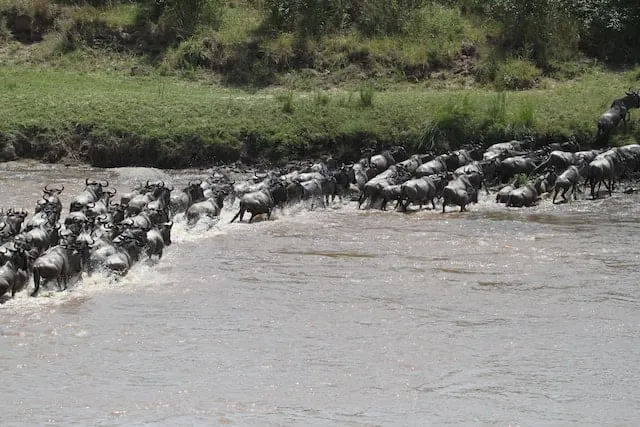Serengeti Migration.

The Serengeti Migration - Nature's Most Spectacular Journey.
On the immense plains of East Africa, the Serengeti Migration, frequently referred to as "The Greatest Show on Earth," is a breathtaking natural event. The Serengeti National Park in Tanzania and the Maasai Mara National Reserve in Kenya are both included in this breathtaking migration of millions of animals.
This article will examine the amazing Serengeti Migration show, from its enormous scale to its ecological relevance.
The Participants in the Migration:
The wildebeests, who are also joined by zebras, Thomson's gazelles, and other herbivores, are at the center of the Serengeti Migration.
With millions of them, the wildebeests particularly dominate the scene. It is a continuous cycle of life, death, and renewal because the need for new grazing pastures and water drives this incredible event.
The Serengeti Migration is a year-round, circular trek that takes place in a number of stages rather than being a singular occurrence.
The migration usually starts in the southern Serengeti, where the wildebeest herds congregate to give birth to their young during the calving season (December to March). The Ndutu Plains' nutrient-dense grasses offer plenty of food for moms and young children.
Grazing on Grasslands (April–June): As the rainy season comes to an end, the herds migrate west and north in search of new pastures. They frequently pass through the western and central corridors of the Serengeti at this phase.
River Crossings (July–October): The river crossings are one of the migration's most spectacular and recognizable features. The Grumeti and Mara Rivers in particular are dangerous for the wildebeests to traverse because of the presence of crocodiles and other predators like lions and leopards.
Return to the South (November–December): Following the river crossings, the herds return to the southern Serengeti for the calving season, bringing to an end one annual cycle and ushering in a new one.
Ecological Significance:
The Serengeti Migration is not merely a tourist attraction; it is an important ecological occurrence with broad ecological ramifications. Here are the advantages of both.
Environmental Sustainability:
Nutrient-cycling animals roam constantly, enriching the grasslands with their feces and aiding in soil fertilization. Both grazers and predators profit from the improved health of the grasses caused by this nitrogen cycling.
Predator-Prey Dynamics:
The migration gives apex predators, such as lions and cheetahs, a plentiful food source, aiding in the maintenance of a healthy environment. It's an amazing illustration of how nature maintains balance.
Biodiversity:
In addition to the spectacular megafauna, the Serengeti Migration supports a wide variety of animals. In this dynamic ecosystem, numerous bird species, scavengers, and smaller mammals also flourish.
Despite being a natural spectacle, the Serengeti Migration has a number of conservation difficulties.
Habitat loss: Human development and agriculture are encroaching on the historic migration routes and habitats.
Changing Climate:
The availability of water and food supplies for the migrating herds can be impacted by changes in temperature and rainfall patterns.
Conflicts between humans and wildlife can occur as the migration passes through places where people live due to resource shortages and worries about their safety.
Responsible tourism is important for the preservation of the Serengeti Migration. To lessen the influence on the ecology, it is crucial to engage in sustainable and responsible tourism practices, such as limiting river crossing watching and observing animal and park regulations.
The Serengeti Migration is evidence of the wonder and intricacy of the natural world, to sum up.
Millions of animals are travelling on this amazing voyage, demonstrating the interdependence of life, the cycles of nature, and the significance of conservation efforts to preserve this breathtaking display for future generations.
The Serengeti Migration is more than just a natural phenomenon; it serves as a reminder of the biodiversity of our planet's long-lasting wonders.
Click here for our next article.


